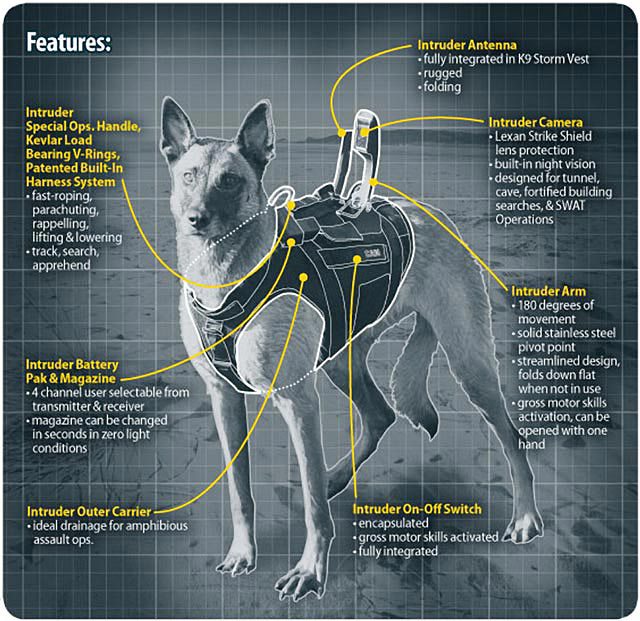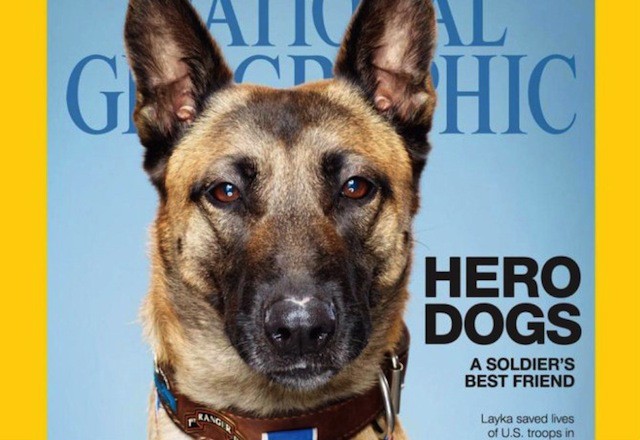-
Of the 80 member team that was deployed to take down bin Laden, few draw more speculation than the one on four legs. Most likely a Belgian Malinois (though officials say it could also have been a German Shepherd), there was one non-human member of the SEAL team that raided Osama bin Laden’s compound, according to the New York Times. The heroic pooch was strapped to a Navy SEAL as they were lowered from a hovering helicopter.
The news of the dog’s use in the raid broke Wednesday, but like the other members of the team that was deployed, its identity remains unknown.
While the dog is known for its bomb-sniffing prowess, it has other capabilities that make it a wonderful dog-of-war. According to the Atlantic, the dog may have been trained to “sniff out enemy troops from up to 2 miles away.”
The sensory perception brought by these dogs in a wartime situation is unparalleled. “The capability they bring to the fight cannot be replicated by man or machine,” General David H. Petraeus said last year, calling for more use of dogs.
But the coolest thing about these guys? Many SEAL dogs come equipped with “titanium fangs capable of ripping through enemy protective armor,” at a cost of “about $2,000 a tooth,” according to the Daily. That’ll get the job done.
Breed: Belgian Malinois
War/Conflict: The War on Terror
Cairo was the dog brought along on Operation Neptune Spear, the Navy SEAL special ops now famous for the location and killing of Osama Bin Laden. Armed with all sorts of equipment and tactical support, Cairo searched the outside of OBL’s compound and helped to secure the perimeter.
While Cairo may not have directly saved the lives of the Navy SEALS who breached Bin Laden’s fortress, there is little doubt that his aid in killing a monster prevented further attacks from Al Qaeda.
Contemporary dogs in military roles are also often referred to as police dogs, or, in the United States, as a Military Working Dog (MWD) or K-9. Their roles are varied, though they are rarely used in front-line missions.
Traditionally, the most common breed for these military-type operations has been the German Shepherd. In recent years, there’s been a shift to smaller dogs of more resilient breeds such as the Belgian Malinois and Dutch Shepherd. These dogs are said to have keener senses of smell for detection work and patrolling. Today, all MWDs are paired with a single individual after their training. This person is called a handler. While a handler usually won’t stay with one dog for the length of either’s career, usually a handler will stay partnered with a dog for at least a year, and sometimes much longer.
Change has also come in legislature for the benefit of the canines. Prior to 2000, older war dogs were required to be euthanized. Thanks to a new law, retired military dogs may now be adopted, the first of which was a dog named Lex, whose handler was killed in Iraq.
-

Cairo was the dog brought along on Operation Neptune Spear, the Navy SEAL special ops now famous for the location and killing of Osama Bin Laden. 

Armed with all sorts of equipment and tactical support, Cairo searched the outside of OBL’s compound and helped to secure the perimeter.
Layka
The concept of canine post-traumatic stress disorder is becoming more apparent as military working dogs show increasing signs of behavioral changes more commonly associated with their human counterparts. Sources say that of 650 dogs deployed by American forces, around 5% are developing PTSD.
PTSD is well-documented among American servicemen and women returning from wars in Iraq and Afghanistan, but its existence in animals is less clear-cut. Some veterinarians say animals do experience it, or a version of it. “There is a condition in dogs which is almost precisely the same, if not precisely the same, as PTSD in humans,” said Nicholas Dodman, head of the animal behavior program at Tufts University’s Cummings School of Veterinary Medicine. The military defines PTSD as a condition that develops after a life-threatening trauma. Victims suffer three types of experiences long afterward, even in a safe environment. They repeatedly re-experience the trauma in nightmares or vivid memories. They avoid situations or feelings that remind them of the event, and they feel keyed up all the time.
The Senate took up the cause of canine heroes who have served in our military and passed a provision that streamlines the adoption process for retired military dogs and authorizes the Department of Defense to provide veterinary care in the animals’ retirement without any cost to American taxpayers. Military dogs perform dangerous, critical tasks, and it is our duty to honor these dogs and ensure they are cared for after their service is complete. The House passed similar language in their version of the military bill earlier this year.
More information about MWDs and MWD adoption:
- Military Working Dog Adoptions
- The United States War Dogs Association
- Joint Base San Antonio at Lackland Working Dog Adoption FAQ
- Military Working Dog Memorial at Rancho Coastal Humane Society
- How War Dogs Work
Research Material: The Atlantic, Huffingtonpost.com, Military.com, National Geographic, Examiner.com
